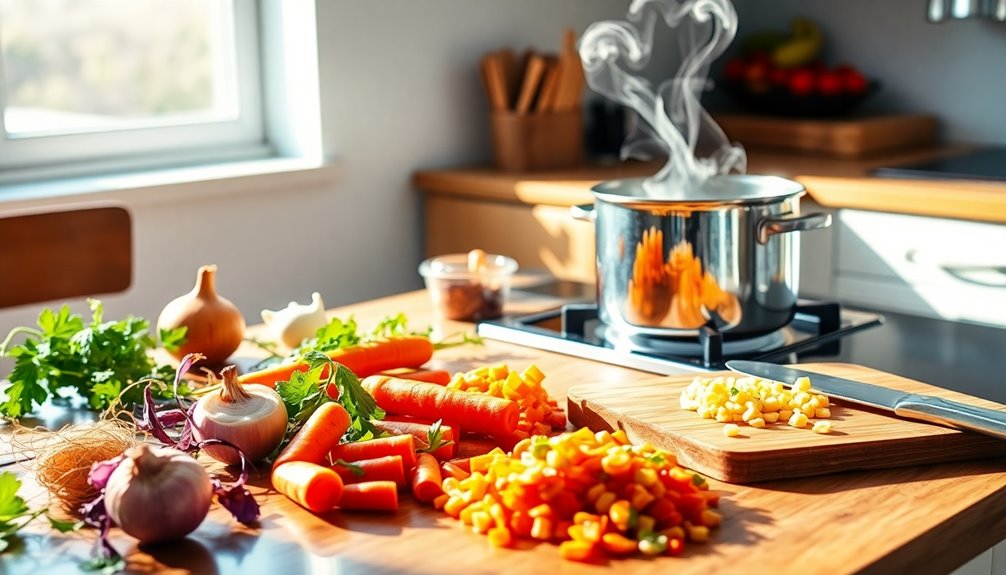You can save money and cut down on food waste by creatively using leftover ingredients. Store bread heels in an airtight container for bread pudding or breadcrumbs. Repurpose pickle juice as a marinade or salad dressing. Turn pea pods into pesto or stir-fry additions. Save vegetable scraps to make flavorful stock. Blend leftover watermelon into invigorating smoothies, and use carrot tops in chimichurri. Don't forget to freeze leftover cooked meats for future meals. Finally, save Parmesan rinds and potato peels for adding flavor and snacks. There's plenty more to explore that can keep your kitchen budget-friendly.
Utilize Bread Heels Creatively
When you find yourself with leftover bread heels, don't toss them out—get creative! These often-overlooked ingredients can transform into delicious baked goods. Storing them in an airtight container or freezing them for future use is a great way to prevent food waste and maximize your budget-friendly cooking efforts. A quick and easy way to enjoy them is by making bread pudding, mixing in eggs, cheese, and vegetables for a hearty dish. Additionally, using expense management apps can help you track how much you're saving by utilizing every part of your ingredients.
You can also turn those stale heels into breadcrumbs, perfect for coating proteins or adding texture to casseroles and meatballs. If you're feeling sweet, try baking crust trimmings with butter and cinnamon sugar for a delightful snack. Additionally, consider using those breadcrumbs in your cooking to help track spending habits, ensuring you make the most of your ingredients and minimize waste.
Repurpose Pickle Juice
If you've just polished off a jar of pickles, don't let that flavorful juice go to waste! Save that pickle juice to add flavor to your meals and help reduce food waste.
Use it as a zesty marinade for chicken or brine your favorite vegetables like carrots and onions to give them a tangy twist. You can even incorporate pickle juice into salad dressings, providing a burst of flavor while keeping calories low. Plus, using leftover ingredients like pickle juice encourages eco-friendly options that reduce paper waste from traditional coupons. Additionally, choosing to repurpose ingredients contributes to sustainable practices that minimize waste in your kitchen.
Replace vinegar in potato salad or coleslaw with pickle juice for a unique taste that elevates these classic dishes.
Feeling adventurous? Mix it into cocktails like a Bloody Mary or a pickleback shot to create innovative drinks that tantalize your taste buds! Additionally, experimenting with leftovers can lead to more sustainable and ethical shopping practices by encouraging creative use of ingredients you already have on hand.
Make Use of Pea Pods
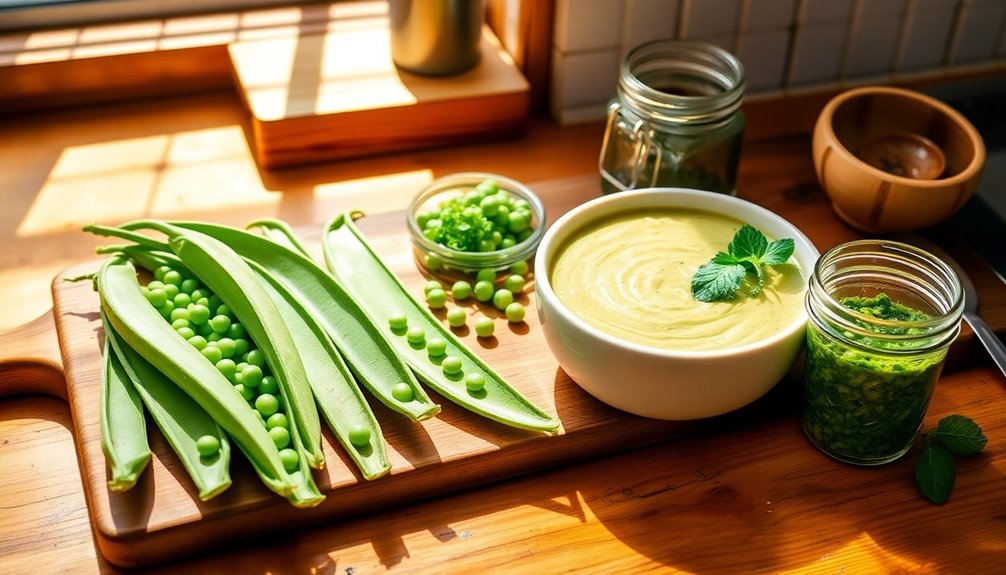
Don't toss those pea pods! You can turn them into delicious recipes that add flavor and nutrition to your meals. Additionally, using these pods can help you track expenses and reduce food waste, aligning with smarter budgeting practices. Let's explore the benefits, creative ways to use them, and smart storage tips to make the most of this often-overlooked ingredient. By incorporating these recipes into your meal planning, you can align expenses with your long-term financial objectives. Moreover, monitoring savings through creative cooking can enhance your overall financial health.
Pea Pod Recipes
Although many people toss out pea pods without a second thought, these vibrant green shells can add a delightful twist to your meals. Here are some creative ways to use them:
- Pea Pod Pesto: Finely chop and blend pea pods with nuts and cheese for a fresh pesto.
- Vegetable Stock: Simmer them in broth to create a nutritious vegetable stock that enhances soups and risottos.
- Crispy Snack: Wash, dry, and fry pea pods until crispy, then season for a healthy chip alternative.
- Stir-Fries and Salads: Incorporate cooked pea pods for a pop of color and added fiber, helping you reduce food waste while maximizing flavor.
Give these recipes a try and enjoy the versatility of pea pods!
Nutritional Benefits Overview
Using pea pods in your cooking not only enhances flavor but also packs a nutritional punch. These vibrant pods are rich in vitamins A, C, and K, along with essential minerals like iron and magnesium.
By adding them to dishes, you gain impressive nutritional benefits while keeping meals low in calories—only about 41 calories per 100 grams. Their dietary fiber promotes digestive health, helping you feel fuller for longer, which is great for weight management.
Plus, with approximately 3 grams of protein per 100 grams, they complement ground beef perfectly. Season with salt and pepper, and you've got a delicious, nutritious meal that reduces food waste while boosting your health.
Creative Storage Solutions
While many people overlook pea pods, they offer great potential when it comes to storage and culinary creativity. By making the most of these versatile veggies, you can save money and reduce waste.
Here are some creative storage solutions for your pea pods:
- Refrigerate: Store fresh pea pods in a breathable bag in the fridge for up to a week.
- Cook and Blend: Create a flavorful paste with garlic and olive oil to enhance dishes.
- Incorporate: Add pea pods directly into soups and stews for extra flavor.
- Freeze: Place unused pea pods in an airtight container to preserve them for future stir-fries or snacks.
Transform Vegetable Scraps
When you start transforming vegetable scraps, you not only reduce waste but also reveal a treasure trove of flavors and nutrients.
Carrot tops, broccoli stalks, and onion peels can be saved to create homemade vegetable stock, maximizing every part of the vegetable. Additionally, incorporating these practices can lead to improved financial allocation by reducing grocery expenses. By tracking your spending habits, you can further enhance discipline in spending while cooking on a budget.
Don't toss those pea pods; cook them down into a paste or toss them into soups for added flavor and nutrition.
You can freeze leftover scraps in airtight containers for easy access later, making meal prep a breeze.
Roasting scraps like beet greens enhances their taste, turning them into a delicious side dish or salad addition. Additionally, utilizing these scraps can be a cost-effective method for managing food expenses while ensuring nothing goes to waste.
Create Smoothies From Watermelon
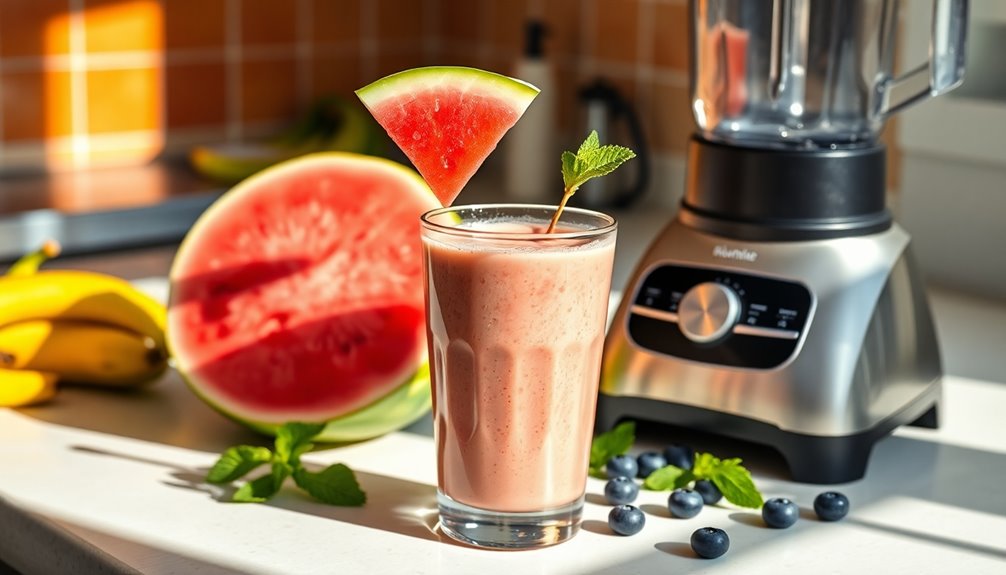
If you've got leftover watermelon, turning it into a smoothie is a delicious way to enjoy its invigorating flavor while cutting down on waste.
Watermelon smoothies aren't only rejuvenating but also nutritious. Here's how to make the most of your leftovers:
- Blend leftover watermelon with lime juice and a splash of coconut water for a hydrating treat. Many people find that user-friendly interfaces in smoothie-making apps can enhance their cooking experience. Additionally, using effective timing of promotions in your budgeting can help you save on fresh ingredients.
- Freeze chunks of watermelon before blending to create a frosty texture without using ice.
- Add yogurt or a scoop of protein powder for creaminess and extra nutrition.
- Toss in a handful of spinach or kale for a nutritious boost that won't alter the sweet flavor.
Feel free to experiment with mint leaves or ginger for a unique twist on your watermelon smoothies! Additionally, incorporating personalized spending plans can help you budget for fresh ingredients to enhance your smoothies.
Overnight Oats in Peanut Butter Jars
Transforming empty peanut butter jars into overnight oats containers not only cuts down on kitchen waste but also infuses your breakfast with a hint of nutty flavor.
To create your delicious overnight oats, combine rolled oats with milk or yogurt in the jar, sticking to a 1:1 ratio for the best creaminess. Feel free to add sweeteners like honey or maple syrup, along with your favorite fruits and nuts.
Once you've sealed the jar, pop it in the refrigerator overnight. This way, the oats absorb the liquid, making a ready-to-eat meal that saves you time in the morning.
Plus, using peanut butter jars gives you a convenient, portable breakfast option, perfect for your busy lifestyle.
Render and Store Meat Fats
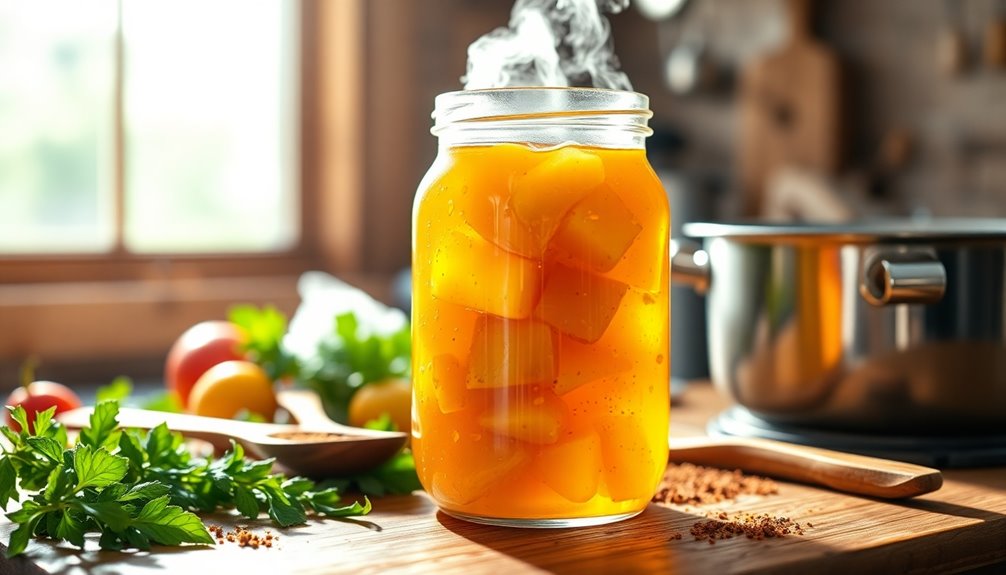
Rendering and storing meat fats, like bacon or duck fat, can elevate your cooking without breaking the bank.
You'll find that these fats not only add incredible flavor but are also versatile in various culinary applications.
Let's explore the different types of meat fats, how to store them properly, and their best uses in your kitchen.
Types of Meat Fats
One of the best ways to elevate your cooking is by utilizing rendered meat fats, like bacon grease and schmaltz.
These fats can enhance the flavor of various dishes and reduce food waste. Here are four types of rendered meat fats you can use:
- Bacon Grease: Great for sautéing vegetables or adding to baked goods for a smoky flavor.
- Schmaltz: Chicken fat that adds richness to soups and matzo balls.
- Lard: Pork fat perfect for flaky pastries and frying.
- Duck Fat: Ideal for roasting potatoes or drizzling on veggies for added depth.
Storage Techniques Explained
Using rendered meat fats can elevate your cooking, but knowing how to store them properly is just as important.
First, render fats like bacon drippings or chicken schmaltz by gently heating them until the solids separate. Strain the liquid fat and pour it into airtight containers.
You can store rendered fats in the refrigerator for up to a month or freeze them for longer shelf life. Be sure to label and date your containers to track freshness. Generally, frozen fats last 3-6 months.
Utilizing rendered fats not only maximizes your ingredients but also enhances the flavor of sautéed vegetables, roasted meats, and baked goods, giving your dishes a richer taste.
Culinary Uses for Fats
When you render and store meat fats, you reveal a world of culinary possibilities that can transform your dishes.
These flavorful rendered fats can replace olive oil or butter, adding depth to your meals while minimizing waste.
Here are some creative uses for your rendered fats:
- Sauté vegetables for a richer taste.
- Roast meats, enhancing their flavor profile.
- Incorporate schmaltz into matzo balls for an authentic touch.
- Use leftover fats for frying, ensuring nothing goes to waste.
Plus, when stored in airtight containers, these fats can last several months in the fridge or freezer.
Use Cilantro Stems for Flavor
Although many cooks toss cilantro stems aside, they actually pack a punch of flavor that can elevate your dishes. These stems share a similar flavor profile with the leaves, making them perfect for enhancing salsas, sauces, and dressings without adding to food waste.
Chop cilantro stems finely and toss them into stir-fries or soups for a fresh, herbaceous note. When making pesto or chimichurri, include them for added depth and texture. You can even use cilantro stems in marinades for meats or seafood, infusing your dishes with aromatic flavor while being budget-friendly.
Brew Pineapple Peel Tea

Brewed from the often-discarded peels of pineapples, pineapple peel tea is a delicious and sustainable way to enjoy the fruit's flavor while minimizing waste.
Follow these simple steps to create this invigorating herbal tea packed with antioxidants:
- Wash the pineapple peels thoroughly to remove dirt and pesticides.
- Boil the cleaned peels in water for 20-30 minutes to extract flavor and nutrients.
- Strain the liquid to remove any peels and sediment.
- Enhance the taste by adding spices like ginger, cinnamon, or a squeeze of lemon juice.
Serve your pineapple peel tea hot or chilled, and relish in its delightful taste while making the most of your leftovers!
Bake Pie Crust Trimmings
Transforming leftover pie crust trimmings into delicious treats is a smart way to reduce waste and enjoy tasty snacks.
Roll out your trimmings to create mini tart shells, perfect for sweet or savory fillings. For a quick dessert, brush the rolled-out crust with melted butter, sprinkle with cinnamon sugar, and bake until golden.
If you're in the mood for something savory, cut the trimmings into strips, twist them, and bake for crispy snacks that pair well with dips or soups. You can also sprinkle small pieces of trimmings over casseroles for a delightful topping.
For a unique twist, combine leftover pie crust trimmings with cheese and herbs for a flavorful crust on quiches or savory pies.
Incorporate Schmaltz in Cooking
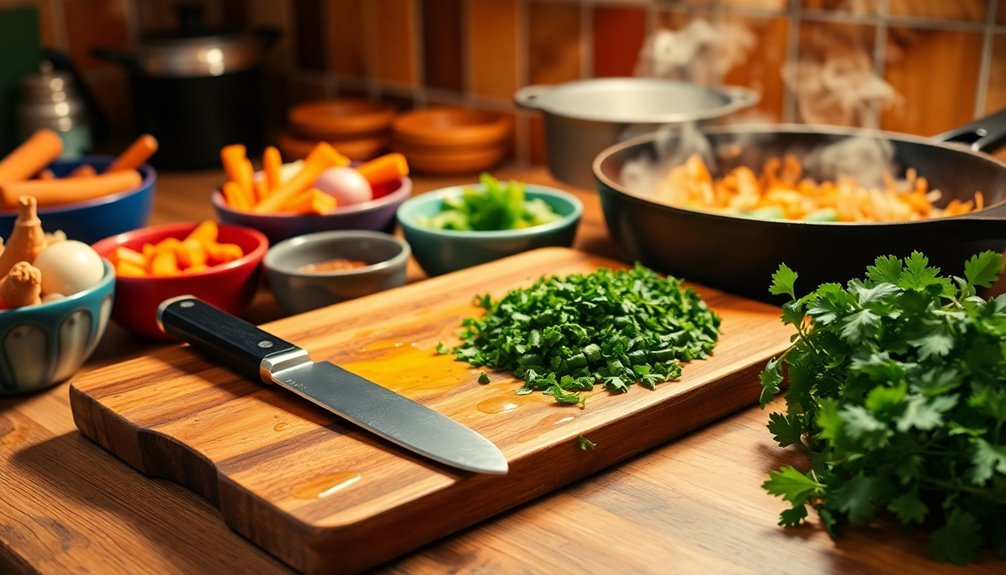
After making those tasty snacks from pie crust trimmings, you might find yourself looking for more ways to elevate your cooking.
One fantastic option is to incorporate schmaltz, or rendered chicken fat, into your dishes. Here are some ideas:
- Scrambled Eggs: Use schmaltz to cook your scrambled eggs for an even better flavor.
- Sautéed Vegetables: Swap butter or oil for schmaltz when sautéing veggies for a savory twist.
- Soups and Stews: Add schmaltz to your chicken stock for a richer broth in soups.
- Spread: Mix schmaltz with herbs or spices and use it as a spread on bread or crackers.
Embrace this budget-friendly ingredient and enjoy enhancing your meals!
Harness Carrot Tops
While you may usually toss carrot tops in the compost, these vibrant greens are packed with nutrients and flavor that can enhance your meals. Instead of discarding them, try blending carrot tops into a zesty chimichurri sauce with garlic, olive oil, and vinegar. This adds a fresh kick to grilled meats and veggies.
You can also finely chop carrot tops and toss them into salads for an extra crunch and burst of freshness, balancing the carrots' sweetness. For a unique twist on the classic sauce, use carrot tops to make pesto by blending them with nuts, Parmesan cheese, and olive oil.
Don't forget to store any leftover carrot tops in a damp paper towel in the fridge to keep them fresh longer!
Freeze Leftover Cooked Meats
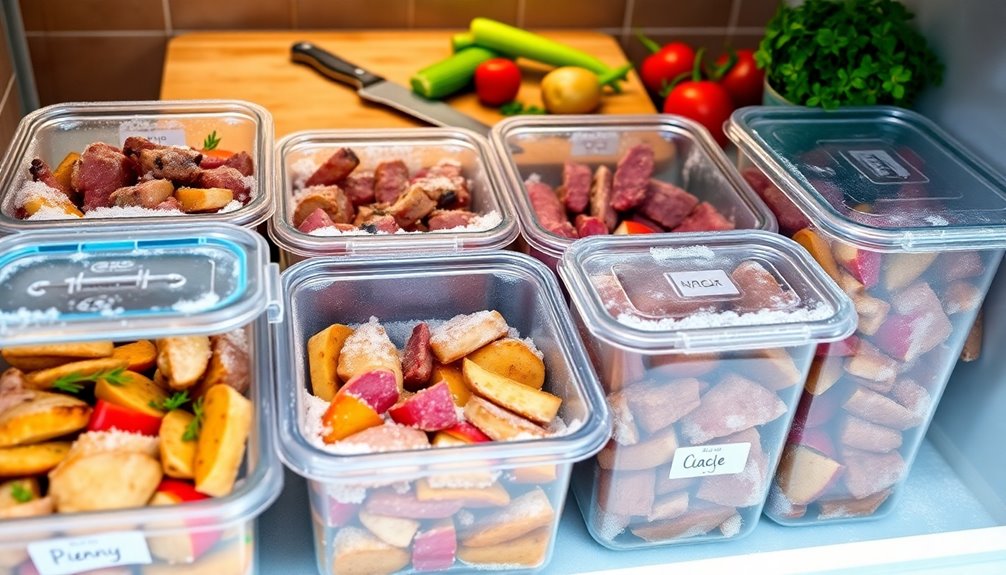
If you're looking to make the most of your meals, freezing leftover cooked meats is a smart strategy that can save you time and reduce food waste.
Here's how to do it effectively:
- Portion cooked meats into individual servings before freezing for easy reheating.
- Wrap meats tightly in plastic wrap or aluminum foil to prevent freezer burn.
- Place wrapped meats in airtight freezer bags to seal in freshness.
- Label each bag with the type of meat and date frozen, ensuring you use them within 2-3 months.
When you're ready to use them, thaw frozen cooked meats in the refrigerator overnight or use the microwave's defrost setting for a quick and safe thawing method.
Enjoy your hassle-free meals!
Save Parmesan Rinds for Flavor
Saving Parmesan rinds might seem like a small step, but it can greatly enhance the flavor of your dishes without adding extra costs.
Store your rinds in an airtight container in the refrigerator or freezer, so you have them on hand for future recipes. When you add Parmesan rinds to soups, stews, or sauces while cooking, they infuse a rich, savory flavor that elevates your dish.
Simply simmer a rind alongside your ingredients for at least 30 minutes, then remove it for maximum flavor extraction. You can also use them in homemade risotto to achieve a creamy texture and deepen the taste.
One rind can flavor multiple servings, making it a smart, budget-friendly choice for enhancing meals.
Enjoy Potato Peel Snacks
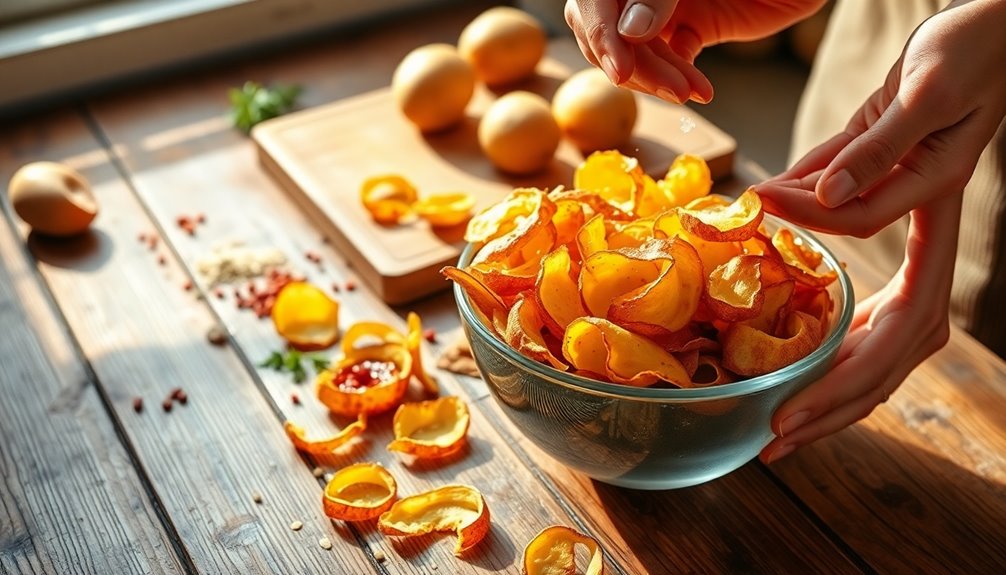
You can turn potato peels into a crunchy snack that's both tasty and budget-friendly.
By experimenting with different seasonings and flavors, you'll find the perfect combination to suit your taste.
Don't forget to pair your crispy treats with dips for a delightful snacking experience!
Crunchy Snack Preparation
While most people toss potato peels in the trash, these often-overlooked scraps can be transformed into a tasty, crunchy snack. You can easily turn them into a delightful treat by following these simple steps:
- Wash and Dry: Rinse the potato peels thoroughly and pat them dry.
- Season: Toss the peels with olive oil, salt, and your favorite seasonings.
- Bake: Spread them on a baking sheet and bake at 400°F for 15-20 minutes until golden and crunchy.
- Store: If you have leftovers, keep them in an airtight container in the fridge for up to a week.
With these tips, you'll enjoy crispy potato peels as a budget-friendly snack that's both satisfying and delicious!
Flavor Variations and Seasoning
After enjoying your crunchy potato peel snacks, consider experimenting with different flavor variations to elevate your snacking experience.
You can wash and dry those often-discarded potato peels, then toss them in a bit of olive oil before frying or baking for added crispiness. Season them with spices like paprika, garlic powder, or onion salt to customize the flavor to your liking. Not only will this make your snacks delicious, but it also helps you reduce food waste.
For a healthier option, bake the potato peels at a low temperature until crispy.
And don't forget, leftover potato peels can enhance soups or broths, maximizing every part of your potatoes while adding nutrients and flavor. Enjoy!
Serving Suggestions and Pairings
To enjoy your potato peel snacks to the fullest, consider serving them with a variety of delicious dips that complement their crunch.
These snacks, seasoned with salt and your favorite spices, can be a delightful alternative to chips. Pairing them with the right dips enhances their flavor and makes for a satisfying treat.
Here are some great options:
- Sour cream
- Guacamole
- Homemade ranch dressing
- Hummus
For best storage, keep any leftover potato peel snacks in an airtight container, retaining their crispiness for up to a week.
You can also get creative by mixing potato peels with other vegetable scraps, elevating your snacking experience while minimizing waste.
Enjoy!
Conclusion
So there you have it—turning what many consider trash into treasure! Who knew those bread heels could be the star of your next meal? And pickle juice? It's not just a condiment; it's a culinary sidekick! By embracing these budget-friendly hacks, you're not just saving money—you're becoming a waste-fighting hero in your kitchen. Just remember, the next time you reach for the trash can, think twice. Your leftovers might have a far more delicious destiny waiting!

